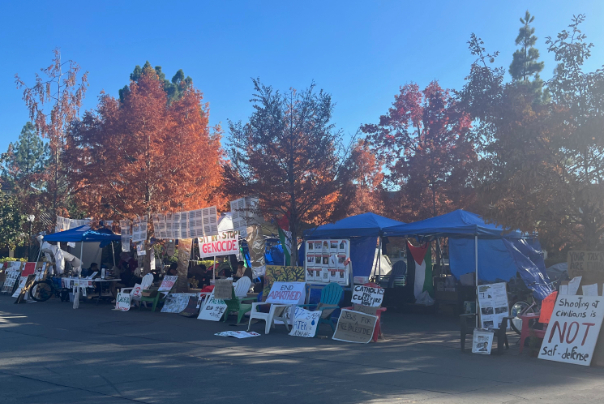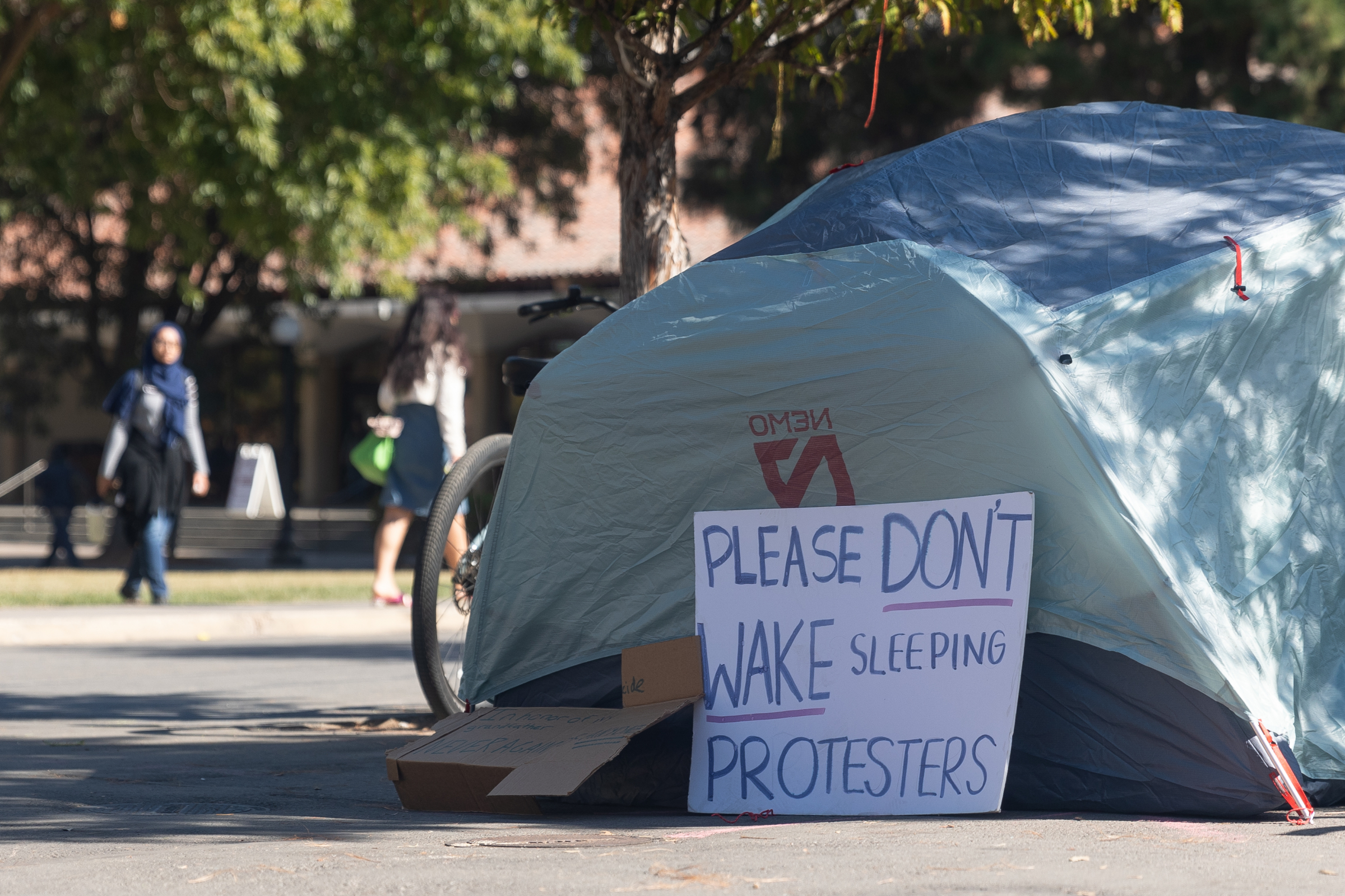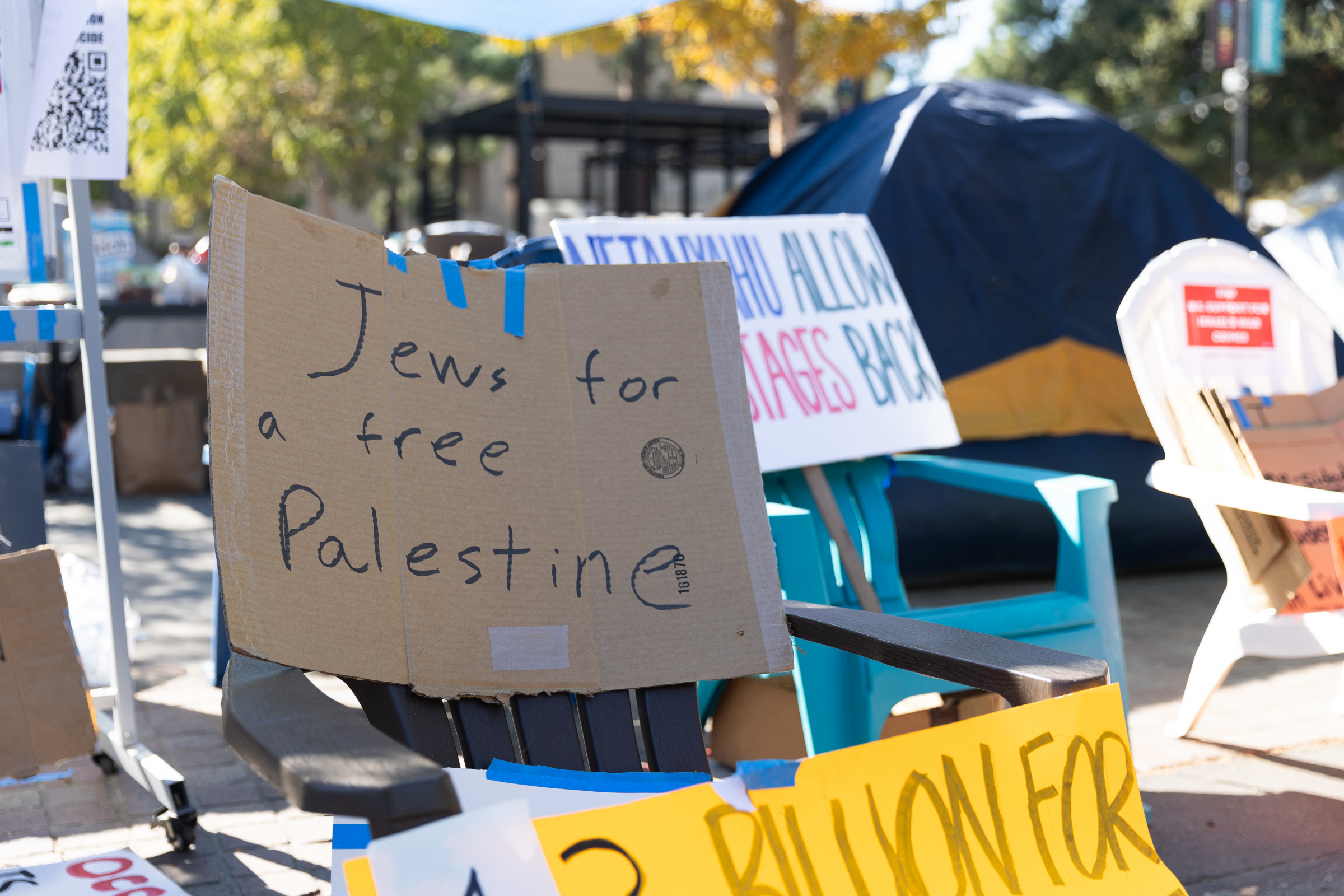At Stanford’s White Plaza, change and movement abounds. Leaves change color, cyclists ride past and students walk to class.
But one element of the campus’s “designated free speech area” has remained, at least for the past 64 days: A student sit-in. The students have been camping out in White Plaza since Oct. 20, and are demanding that the university, among other things, endorse a ceasefire in Gaza, commit to the boycott, divestment and sanction movement and provide resources for Palestinian and Arab students who have been personally affected by the war between Israel and Hamas.
The university has responded to parts of their demands on Nov. 13, outlining the formation of a committee to combat Islamophobia and enhance Muslim, Arab and Palestinian students’ safety. But the students involved with the sit-in have said that they will not leave White Plaza until every single one of their demands are met — though the university does not yet seem to have plans to do so.
College campuses across the country have become the landscape upon which public opinion on the war between Israel and Hamas has played out, and Stanford is no exception. But unlike other issues that campus activists typically advocate for, this is one that, at least in recent memory at Stanford, has large contingents on both sides of the issue.
So what’s next for the student activists as movement from university leaders seems to have stalled? And what happens if university leaders continue to ignore their demands?
A spokesperson for the university said Stanford’s president and provost have met in recent weeks with students involved with the sit-in but did not comment specifically on whether they plan to address the students’ exact demands.
“The university is continuing to work to support the safety and wellbeing of everyone in our community as the Israel-Hamas war continues,” the statement reads.
As Stanford’s winter quarter has come to a close and Stanford housing recently closed for break on Dec. 16, students involved with the sit-in have plans to maintain the sit-in’s presence despite many heading home for the holidays and the onset of colder temperatures.
“We've committed to doing this as long as it takes,” Alisha Service, a student involved with the sit-in, told this publication in an interview.
The future of the sit-in
Amy Binder, a professor of sociology at Johns Hopkins University who has written a book about activism on college campuses, said campus administrators often wait for students to change their focus and slowly lose interest when it comes to issues like this one.
“Students turn over every four years, that's very predictable,” she said. “Final exams may come and students have to turn their attention there,” she said.
She said it’s possible that things at Stanford may fizzle out in the coming weeks and months, as maintaining the sit-in despite little progress towards achieving their demands may become frustrating for students. On the other hand, she said it’s also possible that the students may make progress towards achieving some of their demands and could reconsider which demands they’d be open to conceding in favor of others.
Binder said left-leaning student activists tend to make local leaders, such as campus administrators, the target of their activism on global issues. As such, the demands that many campus activists direct to local leaders are sometimes beyond the scope of their responsibilities, she said.
“Some would argue, and I would be one of them, that Stanford campus leaders actually have no power whatsoever to change world historical events and create the conditions for a ceasefire,” Binder said.
A history of student sit-ins at Stanford
Stanford’s campus has been no stranger to student activism over the years, as students have advocated for divestment of the school’s endowment from fossil fuels, South African apartheid, and more.
The students involved with the ongoing sit-in have referenced the 1985 calls for divestment from apartheid in South Africa saying they are following a tradition of campus activism.
Binder, who is herself a Stanford alumna from the class of 1986, was an undergraduate student during the university’s second round of protests in 1985 calling for the university to divest its endowment from South African apartheid. She said she herself was an ally to the demonstrators at the time, and even wore a sash that read “stop investment in apartheid” at her graduation.
Binder said the South Africa divestment sit-in involved more concise demands that essentially boiled down to a call to divest the university’s endowment from South African apartheid. But she said the current sit-ins’ multifaceted list of demands may hinder their ability to see progress sooner, which could play a role in how long the sit-in may last.
“One of the things that differentiates the situation that we're in now with Israel and Hamas or Israel and Gaza versus South Africa is that there were really no students on campus who took exception to the calls for disinvestment,” she said.
Though the calls to divest from South African apartheid were not fully addressed, students did achieve a key element of their demands: an agreement from Stanford’s board of trustees to sell its thousands of shares in Motorola if it continued sales to South African military and police.
Part of a national movement
On the macro level, the sit-in at Stanford comes as administrators at several private colleges around the country have reprimanded students who are organizing and protesting for some of the same issues that the students involved with Stanford’s sit-in have been advocating for.
Drawing national attention, Columbia University suspended two pro-Palestine student groups in early November for violating unspecified campus event policies, and just days later George Washington University made a similar move.
Echoing sentiments at college campuses across the country, the students involved with Stanford’s sit-in have argued that university leaders have been more accepting of students’ demands for more support for Jewish than Palestinian students.
But the students at Stanford aren’t concerned about being similarly reprimanded, and evidence indicates that they would be right to feel that way –– opening the door for the sit-in to last even longer than just a few months.
Stanford’s guidelines and policies for postering in White Plaza outline specific dimensions for banners allowed in the area and a five-day limit to leave them up, and the sit-in has long since passed this deadline.
Binder said while it’s hard to predict the outcome, it’s unlikely that Stanford officials will make a move to reprimand the sit-in this late into their demonstrations because of the perception that they would be encroaching on students’ freedom of speech.
“I think Stanford would be wise not to reprimand them,” she told this publication in an interview.
Students involved with the sit-in have said that even the university’s lack of enthusiasm to make a statement to the sit-in and continue to meet with them directly is in itself a statement, especially given that they feel university leaders have been much quicker to stand behind Jewish students since the Oct. 7 attack from Hamas.
An allegedly pro-Israel student struck an Arab Muslim student on Stanford’s campus early last month, a hit-and-run that police are investigating as a hate crime. Students involved with the sit-in also criticized Stanford officials at the time for their delay in alerting students of the incident, when they had been much quicker to respond to other instances of anti-semitism.
Service said the students involved with the sit-in aren’t as concerned about facing disciplinary action because if the school was planning to reprimand them, they likely would have done so already.
“The fact of the matter is that the school has made it so that it can take disciplinary action on a lot of things, and it chooses not to,” Service said.




Comments